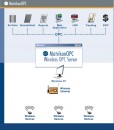Reinforcing its leadership in advanced communications for automation and further proving the company's industrial automation insight, Kepware Technologies today joined forces with DST Controls to better forecast and manage energy demand for a well-known, Salt Lake City e-commerce data center. Responding to requests from the data center's power supplier, DST and Kepware set out to better automate the energy usage management process. View the complete DST case study.
DST Controls is a full-service control systems and industrial data integration company that services customers on five continents. The company's core offering is automated control and monitoring of industrial equipment, processes, and data. When their customer, a Salt Lake City e-commerce provider, needed help addressing energy requirements — they turned to Kepware for help.
"Our e-commerce customer was called on by Rocky Mountain Power to provide more accurate information on energy usage. This was critical as the utility is required to balance load and supply power in real-time," said Greg Dumas, DST Chief Technology Officer. "Monitoring is essential as even a few minutes of warning of demand changes make significant differences in power reliability and cost."
Comprised of 300,000 square feet, the e-commerce data center is staffed by 50 people with 8,000 computers that process web-based orders and shipping information. In the past, collection of data was a very timely process. Dumas said that this type of information is normally very difficult to provide and a highly manual process, "Many customers and utilities manage demand and supply by dispatching their engineers to spend hours creating spreadsheets and calling each other with their latest out-of-date forecasts."
The answer was found via Kepware and its award-winning KEPServerEX®. The KEPServerEX is designed to connect disparate devices — from plant control systems to enterprise information systems. The tool has proven interoperability through drivers and client connectivity for isolated automation systems. KEPServerEX brings centralized communications through a single communications platform, while providing plug-and-play drivers and client interfaces to enable on-demand scalability.
With the integrated solution, data is exchanged using OSIsoft and Kepware — with more than 106 million transactions taking place every day. The Kepware solution monitors approximately 2,000 I/O points; DST reads all servers' power and stores it in a database where Kepware pulls this information from the drivers.
Kobe Mentality 3

 Wireless monitoring of instrumentation sensors such as temperature, flow, pressure, voltage, current, levels, weight, speeds, revolutions and others is a common requirement in the control industry. The term 'wireless' is used for any system used to transfer of information over a distance without the use of electrical conductors or 'wires'. The distances involved may be short (a few meters) like with a television remote or long (thousands or millions of kilometers) for radio or satellite communications. Wireless OPC solutions exist to meet all needs.
Wireless monitoring of instrumentation sensors such as temperature, flow, pressure, voltage, current, levels, weight, speeds, revolutions and others is a common requirement in the control industry. The term 'wireless' is used for any system used to transfer of information over a distance without the use of electrical conductors or 'wires'. The distances involved may be short (a few meters) like with a television remote or long (thousands or millions of kilometers) for radio or satellite communications. Wireless OPC solutions exist to meet all needs.